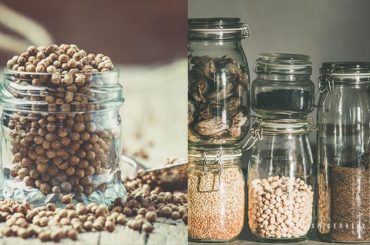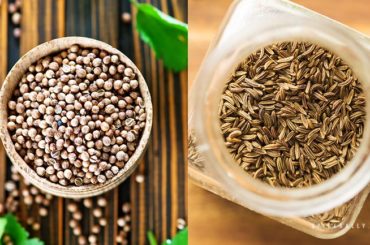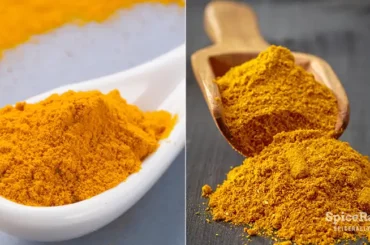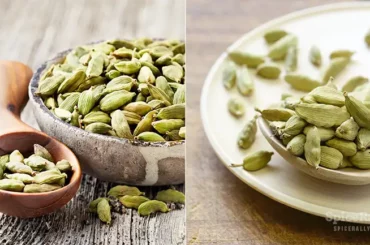Despite the fact that our subject leaders sound similar, they are absolutely different from one another. Thus, in this article, we will unveil some interesting facts about ginger vs ginseng.
Ginger is warmly spicy with sweet, slightly peppery, and citrusy undertones, but ginseng has a more bitter taste with licorice and earthy notes. And ginseng is popularly used in Chinese medicine, while ginger is more popular as a culinary spice.
So, keep reading to learn more about these different yet easily confusing ingredients.
Ginger vs Ginseng
| Ginger | Ginseng | |
|---|---|---|
| Flavor profile | Has a sweeter undertone than ginseng. It is warmly spicy with slightly peppery and citrusy hints. | It is bitter than ginger with earthy and licorice-like undertones. |
| The fragrance profile | Less strongly fragrant than ginseng with warm, lemony, more delicate notes. | Has a bolder and stronger smell than ginger, with sweet and roast flavor notes. |
| Forms | – As fresh rhizomes – Dried rhizomes – Ground – Powdered – Granulated – Pickled – Pills/ capsules – As teas – Preserved – Paste – As an essential oil | – Fresh rhizome/root – Dried rhizome/root – Powdered – In capsules – As an essential oil |
| Availability | Easily available in Asian grocery stores, supermarkets, convenience stores, and online sellers. | Widely available on online shopping sites and can be found mostly in leading supermarkets and Asian stores. |
| Purpose in cooking | As an ingredient and a condiment | As an ingredient |
| Usage in cooking | – Used to flavor curries – It can be used to flavor various beverages. – Is incorporated into stews, soups, broths, and stir-fries. – Powdered ginger is an integral ingredient in many rubs, spice blends, and seasoning mixtures. – Used to make baked goods, candies, and desserts. | – Used mainly as an infusion in herbal teas. – Asian cuisine incorporates ginseng in flavoring broths and soups. – Used to make candies. – It Is incorporated in certain meat dishes. – Is mixed into some rice and noodle dishes. |
| General use | – In cooking and baking – Used as a home remedy for many ailments. – Is an essential ingredient in Ayurveda and traditional medication. – Modern pharmacology uses ginger in making various medicines. | – Mainly used in Chinese apothecary – In cooking – Has a significant role in traditional medication – Modern pharmacology uses ginseng in making their medicines. |
| Health benefits | – Rich in vitamins and minerals. – Helps to alleviate symptoms of morning sickness and nausea. – Supports lowering blood sugar and cholesterol levels. – Boosts brain function. – Supports weight loss. | – Rich in antioxidants. – Helps in male fertility issues and erectile dysfunction. – Boosts the immune system. – Increases energy and decreases stress. – Improves heart health and aids with weight loss. |
| Appearance | Is a fleshy rhizome that is grayish-light brown on the outside and pale yellow on the inside. | Has a light color exterior with forked-shaped roots. It is also known to resemble a figure of a human. |
| Scientific name | Zingiber officinale | – Asian ginseng (Panax ginseng) – American ginseng (Panax quinquefolium) |
| Plant family | Zingiberaceae | Araliaceae |
| Active compounds | – Gingerol – Paradols – Shogaols | Ginsenosides (ginseng saponins) |
| Origin | Southeast Asia | Shangdang, China |
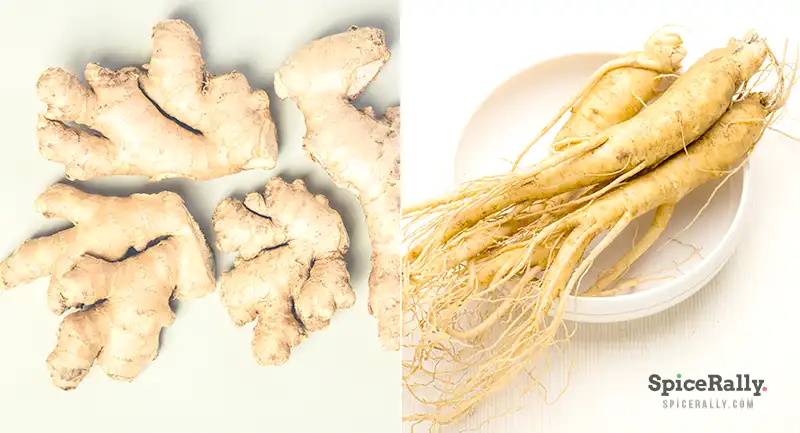
What Is Ginseng In A Nutshell?
Ginseng is a perennial plant with hefty taproots. The part of the plant we are more familiar with is recognized as the rhizome/root of this plant. There are several species of ginseng, but the most used types are Asian ginseng (Panax ginseng) and American ginseng (Panax quinquefolium)
This is one of the essential ingredients used in Chinese medication and is often called the “man root” because it often resembles a figure of a person. And Asian ginseng is considered more stimulating in Chinese medicine than American ginseng.
Apart from its medicinal value, Asian cuisine incorporates this in many of its recipes. The most common ways of consuming ginseng are steeping it with hot water, preparing it as tea, or integrating it with soup. In addition, this ingredient is occasionally used as a spice to flavor certain meat, noodle, rice dishes, and candies.
More Insights Into The Difference Between Ginger And Ginseng…
Although ginger and ginseng sound similar, they are two different plants/spices belonging to different botanical families. However, they both possess many health benefits and are used in cooking, especially in Asian cuisine.
Nevertheless, ginger is considered more versatile, readily available, and ubiquitous when it comes to cooking and baking. In contrast, ginseng is renowned for its properties that would be helpful in traditional medication.
Ginger is incorporated into a wide variety of savory, sweet dishes and beverages, while the usage of ginseng confines to a limited amount of recipes, including herbal teas, soups, and candies.
Moreover, ginger is a rich source of vitamins, minerals, potassium, calcium, magnesium, and iron. While on the contrary, ginseng does not possess many vitamins and minerals. Therefore, due to the availability and accessibility of ginger, it could be collectively more effective to the human body than ginseng.
However, since ginger and ginseng have entirely different flavors and properties, they cannot be used interchangeably in cooking. But, you can take these two ingredients together since there aren’t any proven negative interactions. And they can be a good combination to reduce inflammation and aid in weight loss.

